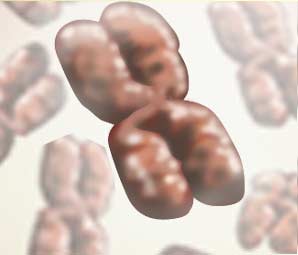

There are two different types of mapping that have an end result of high resolution. They are called Macrorestriction maps (a.k.a. top-down) and Contig maps (a.k.a. bottom up). The DNA fragments that are generated by cutting genomic DNA with restriction enzymes are represented in the order on the maps. Using PCR (polymerase chain reaction) methods, the fragments are amplified. Electrophoretic techniques are used to separate the fragments by size into different bands which can be visualized by DNA staining. Flow sorting from human cell lines or somatic cell hybridization separates the purified chromosome and allows a single chromosome to be mapped.

This is picture of a single chromosome that has been separated from the others so it can be mapped.
To reconstruct the original order of the DNA fragments, a number of strategies can be used:
- Fingerprinting uses restriction map data to determine which fragments have a specific sequence (fingerprint) in common and therefore overlap.
- Another approach uses linking clones as probes for hybridization to chromosomal DNA cut with the same restriction enzyme.
taken from: http://www.genome.iastate.edu/edu/doe/prim2.html